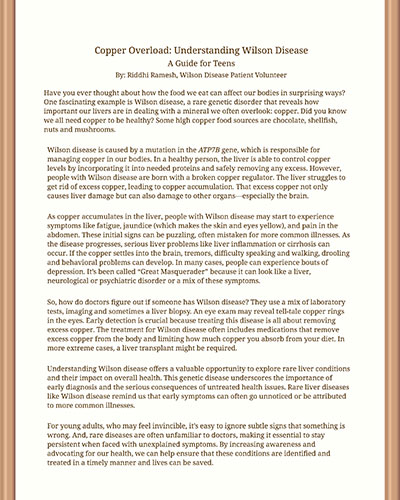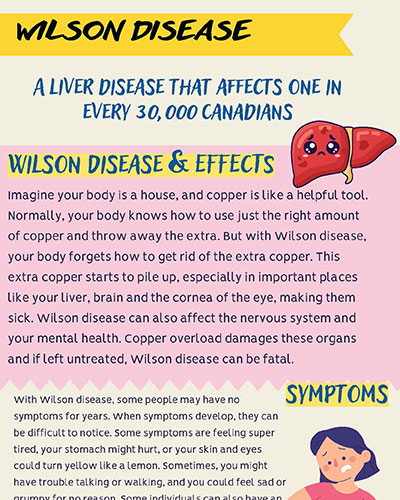Initial diagnosis
Being told that your child has a potentially life-threatening medical condition that will require life-long monitoring and treatment can be a huge shock. On top of that, the genetic nature of Wilson disease can add a certain amount of parental guilt, even though most parents have no idea that they are each carrying one abnormal copy of the ATP7B gene (one abnormal allele). It’s important to know that Wilson disease responds well to treatment, whether the manifestations are mainly hepatic or neurologic. Good response to treatment is most likely when Wilson disease is diagnosed early and adherence to effective medication is consistent.
Sibling testing
All first-degree relatives should be tested. For most families, this means that siblings should be tested right away, since each will have 25% chance of inheriting the same two defective ATB7B alleles from their parents. Diagnosis in the asymptomatic phase permits pre-emptive treatment, which limits organ damage and prevents the development of symptoms.
Diet change for the family
Learn about copper conscious eating. The common foods with high copper content include shellfish, seeds and nuts, and chocolate. It is often best to adopt copper-conscious eating for the entire family. This may mean eliminating chocolate from the home pantry shelves, at least for 6-12 months after diagnosis. Anyone on a restricted diet, such as vegetarians, should consult with a dietitian for personalized dietary guidance. It is important to maintain a healthy weight. For those in the appropriate age-bracket, alcoholic beverages should be avoided because alcohol can increase hepatic damage caused by retained copper.
Biopsies and MRI scans
MRI scans may be performed to image the brain or the liver. MRI scans can take a long time and require more patient cooperation (staying still) than x-rays or ultrasound. For these reasons, a young child may need sedation or general anesthesia for an MRI scan. A liver biopsy provides a tissue sample for determining the copper content in the liver. Microscopic changes in the liver tissue may point to the diagnosis of Wilson disease or indicate how advanced the liver damage is. Obtaining a liver biopsy may be recommended even when the symptoms are mostly neurologic, or when the diagnosis has been made from blood tests, urinary copper excretion, and genotyping results. In general, liver biopsy is performed with a special needle and very effective local anesthesia, along with some sedation.
Medication adherence
Zinc and the oral chelators (D-penicillamine, trientine) all need to be separated from food intake by approximately 2 hours. This is probably the hardest part for children and youth living with Wilson disease: timing their food intake around the medications they need to take every day and bringing their medication with them for the day. Parental or cellphone reminders and liaison communication with the school nurse will be key for success. Zinc typically needs to be taken three times per day, but the oral chelators can be taken twice daily, an easier regimen which tends to enhance adherence.
School
Neurologic abnormalities involving speech, handwriting and motor skills will impact school performance. Accommodations should be sought through the school guidance counselor to allow more time for tests and the use of a keyboard or computer as necessary for tests or note-taking. In some cases, finding a scribe may be advantageous. Speech therapy at school is essential if the child or youth has dysarthria or similar difficulty speaking. Occupational and physical therapy assessments may be needed as well.
Lifestyle
As young adults move away from home, the key considerations involve independent self-care of Wilson disease and minimizing additional liver injury, such as that from fatty liver. Specific pointers include:
- maintaining a healthy weight by avoiding “junk food” and getting enough exercise
- avoiding vitamins and food supplements which contain copper
- limiting copper-rich foods
- avoiding alcohol
- taking medication consistently
- navigating new health insurance in countries without universal health insurance
- arranging medical follow-up and monitoring, which may involve navigating transition from pediatric to adult providers or to providers in a new geographic locale
Written by Karen Quellen, MD and reviewed by Eve Roberts, MD, WDA Medical Advisory Committee member
Donations
Why Your Donation Matters
Your donation to the Wilson Disease Association does more than keep the lights on—it powers education, awareness and action. With your support, we’re able to maintain vital resources like this website, produce trusted educational materials, fund critical research and host events that bring together patients, caregivers and medical professionals. Most importantly, your generosity helps raise awareness so more people are diagnosed earlier and treated effectively—giving them the best chance at a full, healthy life.
When you give, you’re not just supporting an organization—you’re joining a powerful movement to change the future of Wilson disease. You’ll stay informed about the latest in research and treatment, gain access to exclusive webinars and educational resources, and remain connected to a global community that understands. For more than 40 years, our shared commitment has fueled advances in care, deepened understanding, and amplified the voices of those affected by Wilson disease. Together, we’re building a stronger, more informed future.




